18
Formative Assessment: Electricity
What is Electricity?
Electricity is the movement of electrons (negatively charged particles) from one atom to another. This flow of electrical charge is called a current.
What is a Circuit?
A circuit is a path through which electricity can flow. The word “circuit” has the same root as the word “circle”, meaning to go around.
- Closed circuit: The circle is closed, so energy is flowing.
- Open circuit: The circle is open, so energy cannot flow.
To make a simple circuit, you need three things:
- Battery: source of potential energy in the form of electricity
Watch the video, below, to see how batteries work:
Video credit: “How Batteries Work” by Adam Jacobson/TED-Ed is licensed under CC BY-NC-ND 4.0
- Copper wire: path for the electricity to flow in through the circuit. Copper is a good conductor of electricity so it is often used for wires.
- Light bulb: uses electricity from the circuit to light up
Chemical reactions inside the battery cause electrons to build up at the anode (the negative side). They want to get to the cathode (the positive side), but a separator blocks them from traveling within the battery. As seen in the image, below, a copper wire is needed to connect the two sides and provide a path for the electrons.
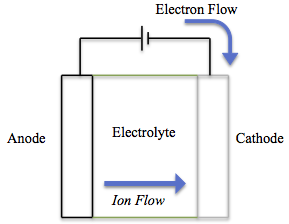
The diagram, below, shows a simple circuit. The current flows from the negative side of the battery, through the copper wire to the light bulb, and then through the copper wire to the positive side of the battery. Additionally, a switch can be used to turn the flow of electricity on (closed circuit) and off (open circuit).
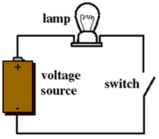
Types of Circuits
- Series circuit: Electricity flows through one continuous loop
In the image, below, electricity flows to each light bulb (represented by a circle with an X) through one continuous path.
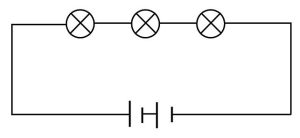
- Parallel circuit: Electricity flows through multiple loops in the same circuit
As seen in the image, below, electricity flows to each light bulb (represented by a circle with an X) through a different path within the same circuit.
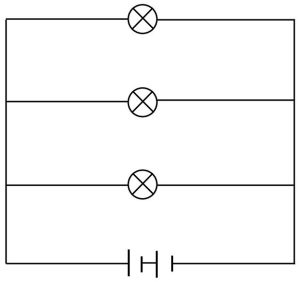
To understand series and parallel circuits, it is helpful to use the example of holiday lights.
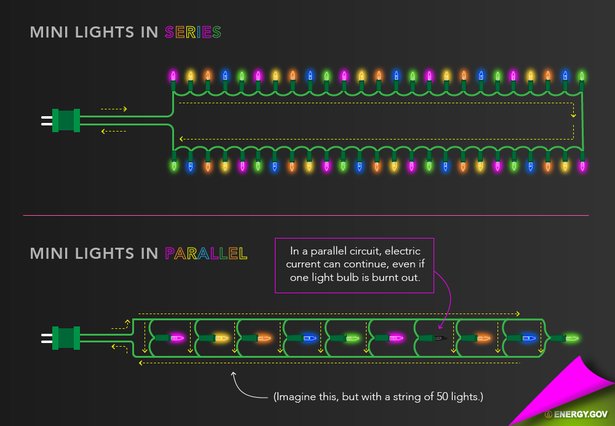
As seen in the image, above, holiday lights can be wired in a series or a parallel circuit.
- In a series circuit, each light is wired through the same continuous path. So if one light burns out, the flow of energy through the circuit is interrupted and the entire string of lights will not work.
- In a parallel circuit, each light is connected to the circuit by a separate pathway. Thus, if one light burns out, all of the other lights will continue to function.
For more information about electricity and circuits, watch the video below:
Video credit: “Electricity and Electric Circuits” by Bozeman Science is licensed under CC BY 3.0
Electricity in Nature
Humans use electricity as a power source, but it occurs everywhere. Lightning is the most obvious example of electricity in nature. The animations, below, illustrate how lightning occurs.
1. During a thunderstorm, particles inside clouds (mostly ice crystals) begin to move rapidly due to the energy of the storm. As these particles collide, they become positively or negatively charged.
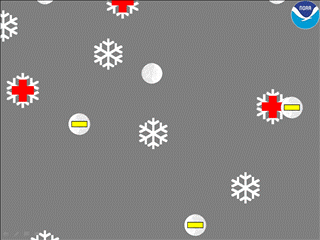
2. Positive and negative charges build up within clouds and the atmosphere. Smaller particles lose electrons so they become positively charged and move into the upper part of the cloud. Larger particles gain these electrons so they become negatively charged and move into the lower part of the cloud.
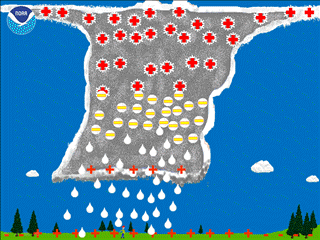
3. When separated charges build up enough, they are discharged in the form of lightning. Lightning can occur between clouds or between clouds and the ground.
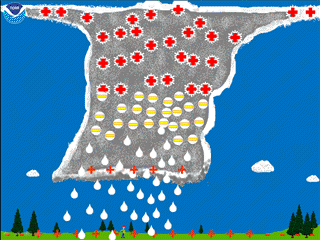
Interestingly, lightning does not only happen during thunderstorms. Scientists have observed lightning in space on Jupiter and Saturn. It can also happen during volcanic eruptions, as seen in the image, below. Before an eruption, ash particles are densely packed within the volcano. When a volcano erupts, the ash particles rapidly move and collide which causes them to become positively and negatively charged. Like in a storm cloud, the charged particles separate and lightning occurs.
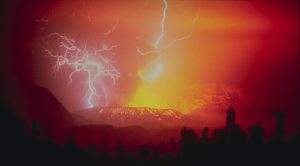
Electricity is also found in living things. For example, neurons in the human brain use electricity to send messages between cells. Some fish, such as electric eels, also produce their own electricity to locate and stun prey. Watch the video, below, to learn how this works.
Video credit: “How Do Fish Make Electricity?” by Eleanor Nelsen/TED-Ed is licensed under CC BY-NC-ND 4.0
NGSS
Performance Standards:
| 3-PS2-3. | <span class="popup" style="cursor: pointer" title="" data-original-title="
Asking Questions and Defining ProblemsAsking questions and defining problems in grades 3–5 builds on grades K–2 experiences and progresses to specifying qualitative relationships.
“>Ask questions to determine <span class="popup" style="cursor: pointer" title="" data-original-title=" Cause and Effect
“>cause and effect relationships <span class="popup" style="cursor: pointer" title="" data-original-title=" PS2.B: Types of Interactions
“>of electric or magnetic interactions between two objects not in contact with each other. [Clarification Statement: Examples of an electric force could include the force on hair from an electrically charged balloon and the electrical forces between a charged rod and pieces of paper; examples of a magnetic force could include the force between two permanent magnets, the force between an electromagnet and steel paperclips, and the force exerted by one magnet versus the force exerted by two magnets. Examples of cause and effect relationships could include how the distance between objects affects strength of the force and how the orientation of magnets affects the direction of the magnetic force.] [Assessment Boundary: Assessment is limited to forces produced by objects that can be manipulated by students, and electrical interactions are limited to static electricity.] |
|---|
| 4-PS3-2. | <span class="popup" style="cursor: pointer" title="" data-original-title="
Planning and Carrying Out InvestigationsPlanning and carrying out investigations to answer questions or test solutions to problems in 3–5 builds on K–2 experiences and progresses to include investigations that control variables and provide evidence to support explanations or design solutions.
|
|---|
| 4-PS3-4. | <span class="popup" style="cursor: pointer" title="" data-original-title="
Constructing Explanations and Designing SolutionsConstructing explanations and designing solutions in 3–5 builds on K–2 experiences and progresses to the use of evidence in constructing explanations that specify variables that describe and predict phenomena and in designing multiple solutions to design problems.
|
|---|
| 4-ESS3-1. | <span class="popup" style="cursor: pointer" title="" data-original-title="
Obtaining, Evaluating, and Communicating InformationObtaining, evaluating, and communicating information in 3–5 builds on K–2 experiences and progresses to evaluate the merit and accuracy of ideas and methods.
|
|---|
| MS-PS2-3. | <span class="popup" style="cursor: pointer" title="" data-original-title="
Asking Questions and Defining ProblemsAsking questions and defining problems in grades 6–8 builds from grades K–5 experiences and progresses to specifying relationships between variables, and clarifying arguments and models.
“>Ask questions about data to determine <span class="popup" style="cursor: pointer" title="" data-original-title=" PS2.B: Types of Interactions
“>the factors <span class="popup" style="cursor: pointer" title="" data-original-title=" Cause and Effect
“>that affect <span class="popup" style="cursor: pointer" title="" data-original-title=" PS2.B: Types of Interactions
“>the strength of electric and magnetic forces. [Clarification Statement: Examples of devices that use electric and magnetic forces could include electromagnets, electric motors, or generators. Examples of data could include the effect of the number of turns of wire on the strength of an electromagnet, or the effect of increasing the number or strength of magnets on the speed of an electric motor.] [Assessment Boundary: Assessment about questions that require quantitative answers is limited to proportional reasoning and algebraic thinking.] |
|---|
| MS-PS2-5. | <span class="popup" style="cursor: pointer" title="" data-original-title="
Planning and Carrying Out InvestigationsPlanning and carrying out investigations to answer questions or test solutions to problems in 6–8 builds on K–5 experiences and progresses to include investigations that use multiple variables and provide evidence to support explanations or design solutions.
“>Conduct an investigation and evaluate the experimental design to provide evidence that <span class="popup" style="cursor: pointer" title="" data-original-title=" PS2.B: Types of Interactions
“>fields exist between objects <span class="popup" style="cursor: pointer" title="" data-original-title=" Cause and Effect
“>exerting forces on each other <span class="popup" style="cursor: pointer" title="" data-original-title=" PS2.B: Types of Interactions
“>even though the objects are not in contact. [Clarification Statement: Examples of this phenomenon could include the interactions of magnets, electrically-charged strips of tape, and electrically-charged pith balls. Examples of investigations could include first-hand experiences or simulations.] [Assessment Boundary: Assessment is limited to electric and magnetic fields, and limited to qualitative evidence for the existence of fields.] |
|---|
DCI
3rd grade
PS2.B: Types of Interactions
- Objects in contact exert forces on each other. (3-PS2-1)
- Electric, and magnetic forces between a pair of objects do not require that the objects be in contact. The sizes of the forces in each situation depend on the properties of the objects and their distances apart and, for forces between two magnets, on their orientation relative to each other. (3-PS2-3),(3-PS2-4)
4th Grade
PS3.A: Definitions of Energy
PS3.B: Conservation of Energy and EnergyTransfer
PS3.D: Energy in Chemical Processes and Everyday Life
ESS3.A: Natural Resources
Middle School
PS2.B: Types of Interactions
- Electric and magnetic (electromagnetic) forces can be attractive or repulsive, and their sizes depend on the magnitudes of the charges, currents, or magnetic strengths involved and on the distances between the interacting objects. (MS-PS2-3)
- Gravitational forces are always attractive. There is a gravitational force between any two masses, but it is very small except when one or both of the objects have large mass—e.g., Earth and the sun. (MS-PS2-4)
- Forces that act at a distance (electric, magnetic, and gravitational) can be explained by fields that extend through space and can be mapped by their effect on a test object (a charged object, a magnet, or a ball, respectively). (MS-PS2-5)
Crosscutting
Cause and Effect
- Cause and effect relationships are routinely identified. (3-PS2-1)
- Cause and effect relationships are routinely identified, tested, and used to explain change. (3-PS2-3)
Energy and Matter
Cause and Effect
Lesson Ideas:
Ted had some really great ideas for prompts for challenges to do with electricity. Kids would do well with them. (get prompts)
The movement of electrons from one atom to another creating a flow of electrical charge
The energy held by an object that gives it capacity to do work.
A flow of electrical charge
A path through which electricity can flow.
A circuit where electricity flows through one continuous path
A circuit where electricity flows through multiple paths
